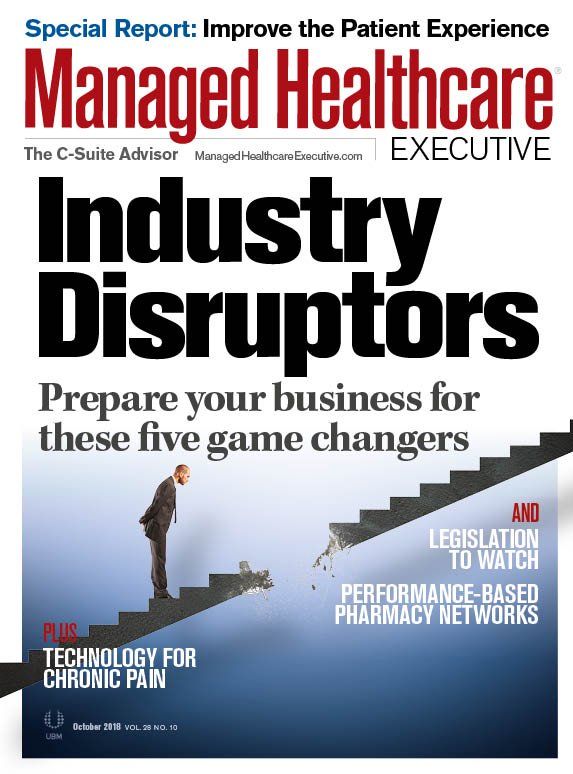Five Disruptors Healthcare Executives Must Watch
In the managed healthcare market, words like logical, predictable, or stable are seldom used anymore. Instead, for healthcare executives, disruption is the norm.
Hall

A change is occurring, and it’s not the type of change we typically talk about in the shifting healthcare landscape. It is a change requiring us, as healthcare leaders, to acquire new skills, talents, and capabilities as we lead new and expanded teams of people in the treatment of patients.
Physician leaders, in particular, are trained well to do many things. We perform highly technical skills and complicated procedures. We manage multiple needs at the same time. We take an unstructured human narrative, break it down into individual components, and develop an entire care plan-determining if and when others are needed. We are trained well for one-to-one interactions with our patients. This training has made us very good at a certain type of leadership-one that is based on hierarchy and a top-down approach.
Unfortunately, this team dynamic and leadership style is not effective in a value-based reimbursement model, where better health outcomes for chronically-ill patients is the measure of success.
In the managed healthcare market, words like logical, predictable, or stable are seldom used anymore. Instead, for healthcare executives, disruption is the norm. The usual change drivers-an aging population dealing with more chronic illness and the increasing problems of affordability and government regulation-are coupled with other disrupters that make it even more difficult for healthcare executives to find the right course. These include:
Chaos at the federal level
While the federal government has long been a disruptive force in healthcare, this has generally been related to new policies, programs, or approaches. We’ve entered an era with no clear federal policy except eliminating and destabilizing previous approaches such as the ACA.
Innovations at the state level
Due to the lack federal direction on healthcare, some states are considering new approaches to cover their residents, including Medicaid buy-in programs and even Medicaid for all. Others are evaluating moving from Medicaid capitation to fee-for-service, increasing emphasis on value-based contracts, and expanding their focus on quality and outcomes.
Many new states are pursuing Medicaid expansion. This includes work and other requirements that force health plans into roles beyond their expertise. These new requirements are sometimes not included in rate calculations, thus resulting in rates that are not actuarially sound.
Impact of social determinants of health
The awareness that a person’s social conditions has a greater impact on their health than their genetics has emerged as a significant driver for how health plans approach member services. Lack of food security, housing, transportation, or a safe environment are enormous contributors to preventable morbidity and mortality and are beginning to be incorporated into care plans and health plans’ outreach efforts and community initiatives. In addition, insurers are forging new partnerships with community partners to ensure access to these services.
Introduction of precision medicine
This rapidly emerging approach to treating disease considers individual genetic, environmental, and lifestyle variability and is reshaping how many medical conditions are treated. While usually more effective than previous approaches, precision medicine is often more expensive and has fewer provider network options. While many health plans aren’t covering precision medicine, clinical studies demonstrating effectiveness will push consumer demand for its coverage.
Entrance of eBusiness
With Amazon’s announcement of its intent to purchase PillPack and its partnership with JP Morgan Chase and Berkshire Hathaway to establish a disruptive new healthcare enterprise, Jeff Bezos is clearly eyeing healthcare as a market open to business opportunities. Apple and Google also have investments in healthcare initiatives. Even unintentionally, ebusiness is disrupting healthcare as demonstrated by Uber’s impact on reducing traditional ambulance services.
Why so much disruption?
At $3.5 trillion, the healthcare industry comprises 21% of the U.S. economy. Despite investing far more in Americans’ healthcare than any other country does, the United States delivers poor results in terms of affordability, quality, access, and outcomes. Until there’s a balance between the dollars invested in healthcare and the results obtained, significant changes in products, strategies, competitors, and federal and state regulation will continue. For healthcare executives, trying to achieve this balance should be their consuming focus. Disruption is not going away, it will only become even more frequent and rapid.
Don Hall, MPH, is principal of DeltaSigma LLC, a consulting practice specializing in strategic problem solving for managed care organizations. He most recently served as president and chief executive officer of a nonprofit, provider-sponsored health plan.

Chief Pharmacy Officer Jason R. Smith on the Challenges Health Systems Face
May 28th 2025Jason R. Smith, Pharm.D., appointed as chief pharmacy officer in February 2025 for the University of Rochester Medical Center, talks about building a stronger workforce, managing drug shortages and keeping up with changes in regulations because of the new administration.
Read More
In the Scope of Virtual Health and the Future of “Website” Manner, Per Ateev Mehrotra
August 10th 2023Briana Contreras, an editor of Managed Healthcare Executive, had the pleasure of catching up with MHE Editorial Advisory Board Member, Ateev Mehrotra, MD, MPH, who is a professor of healthcare policy at Harvard Medical School and an Associate Professor of Medicine and Hospitalist at Beth Israel Deaconess Medical Center.
Listen